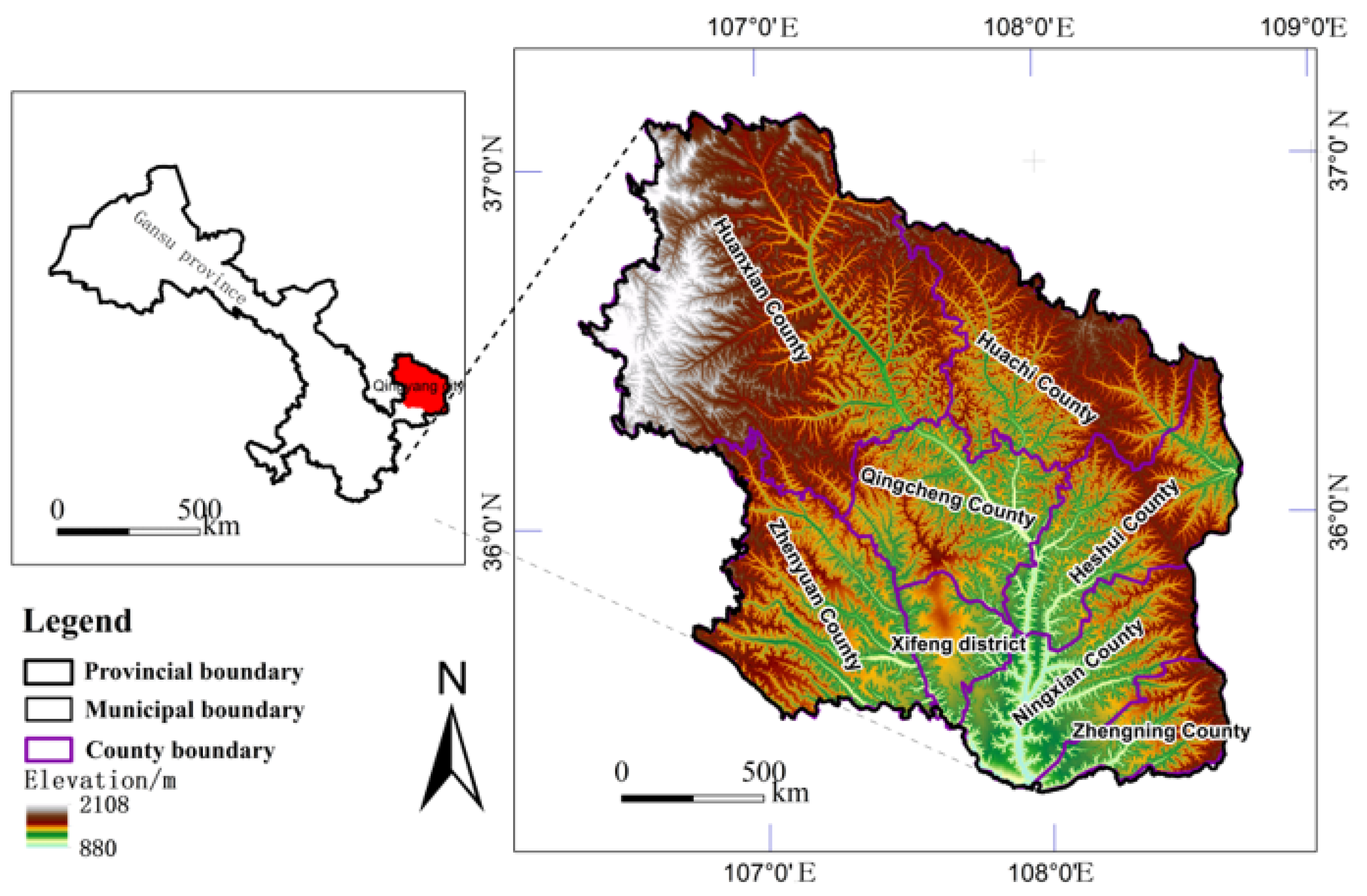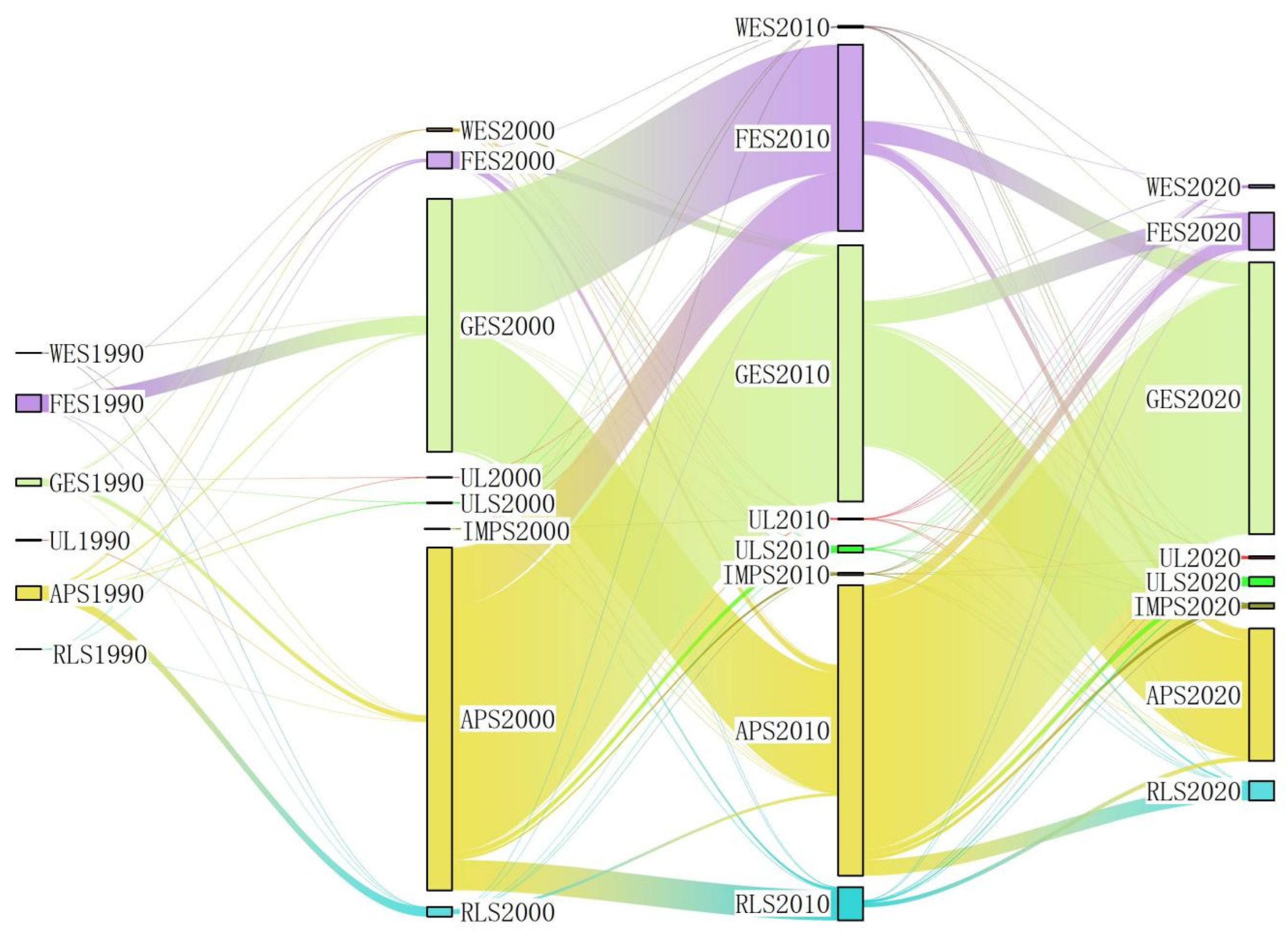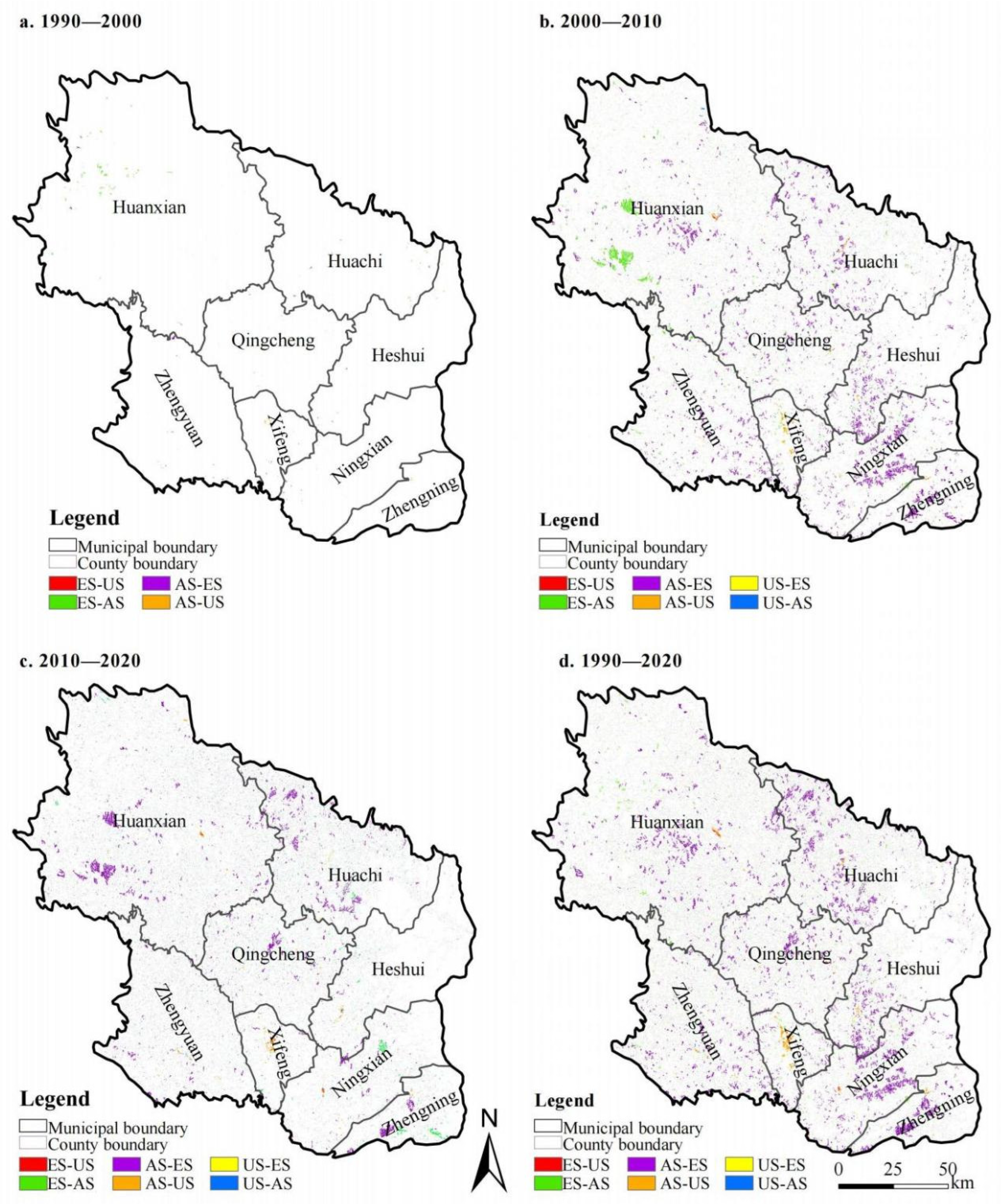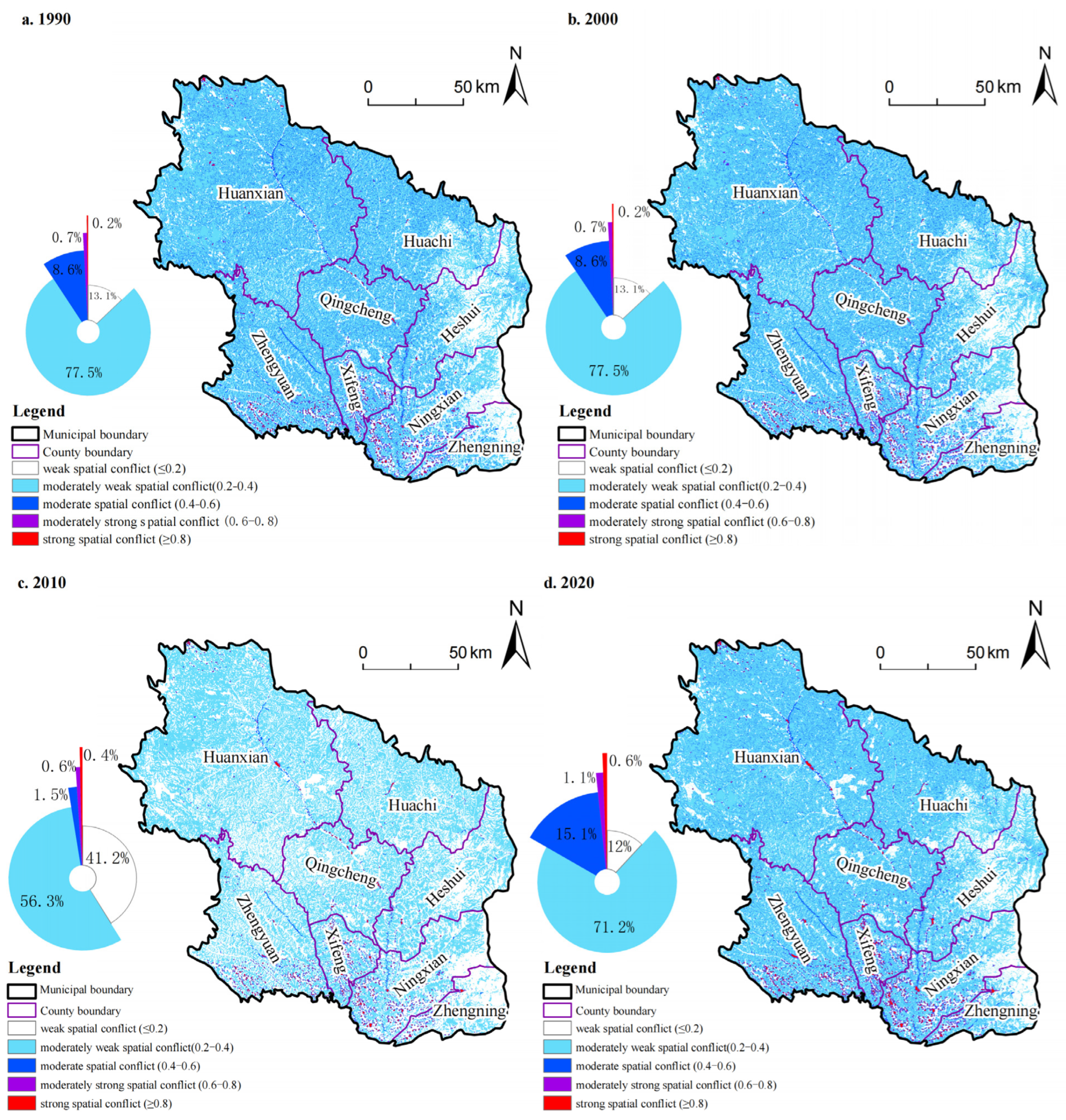Quantification and Analysis of Factors Influencing Territorial Spatial Conflicts in the Gully Region of the Loess Plateau: A Case Study of Qingyang City, Gansu Province, China
Abstract
:1. Introduction
2. Study Area and Data Sources
2.1. Overview of the Study Area
2.2. Data Sources and Processing
3. Research Methods
3.1. Analysis of Changes in Territorial Spatial Structure
3.2. Construction of the Comprehensive Index for Territorial Spatial Conflicts
3.3. Optimal Parameter Geographic Detector (OPGD)
- Spatial differentiation and factor detection
- Parameter optimization
4. Results
4.1. Characteristics of Territorial Spatial Evolution
4.1.1. Spatiotemporal Patterns of Territorial Spatial Evolution
- Ecological spaces show a general trend of expansion.
- Urban space has expanded considerably.
- Agricultural space has generally shown a trend of contraction.
4.1.2. Characteristics of Territorial Spatial Structure Transformation
4.2. Spatiotemporal Evolution Characteristics of Territorial Spatial Conflicts
4.2.1. Temporal Variation Characteristics
4.2.2. Spatial Differentiation Characteristics
4.3. Analysis of Factors Influencing the Evolution of Territorial Spatial Conflicts
4.3.1. Selection of Influencing Factors
4.3.2. Detection of Influencing Factors
- Optimal Parameter Selection
- Single-factor detection analysis
- Multi-factor interactive detection analysis
5. Discussion
5.1. Geomorphic Constraints and Spatial Competition Between Human Activities
5.2. Dual Effects of Policy Interventions and Spatial Compatibility Challenges
5.3. SDGs-Oriented Pathways for Conflict Mitigation
- SDG11 (Sustainable Cities)
- SDG2 (Zero Hunger) and SDG15 (Life on Land)
5.4. Limitations and Future Research Directions
6. Conclusions
Author Contributions
Funding
Institutional Review Board Statement
Informed Consent Statement
Data Availability Statement
Acknowledgments
Conflicts of Interest
References
- Liu, J.; Ning, J.; Kuang, W.; Xu, X.; Zhang, S.; Yan, C.; Li, R.; Wu, S.; Hu, Y.; Du, G.; et al. Spatio-temporal patterns and characteristics of land-use change in China during 2010–2015. Acta Geogr. Sin. 2018, 73, 789–802. [Google Scholar] [CrossRef]
- Adam, Y.O.; Pretzsch, J.; Darr, D. Land Use Conflicts in Central Sudan: Perception and Local Coping Mechanisms. Land Use Policy 2015, 42, 1–6. [Google Scholar] [CrossRef]
- Delphin, S.; Snyder, K.A.; Tanner, S.; Musálem, K.; Marsh, S.E.; Soto, J.R. Obstacles to the Development of Integrated Land-Use Planning in Developing Countries: The Case of Paraguay. Land 2022, 11, 1339. [Google Scholar] [CrossRef]
- Wang, G.; Wang, J.; Wang, L.; Zhang, Y.; Zhang, W. Land-Use Conflict Dynamics, Patterns, and Drivers under Rapid Urbanization. Land 2024, 13, 1317. [Google Scholar] [CrossRef]
- Zhao, G.; Mu, X.; Wen, Z.; Wang, F.; Gao, P. Soil Erosion, Conservation, and Eco-Environment Changes in the Loess Plateau of China. Land Degrad. Dev. 2013, 24, 499–510. [Google Scholar] [CrossRef]
- Long, H.; Kong, X.; Hu, S.; Li, Y. Land Use Transitions under Rapid Urbanization: A Perspective from Developing China. Land 2021, 10, 935. [Google Scholar] [CrossRef]
- Zhang, L.; Zhou, D.; Fan, J.; Zhang, H.; Yue, X. Consistency analysis of the spatial distribution patterns and their drivers of the ecological vulnerability on the Loess Plateau. Acta Ecol. Sin. 2024, 44, 10096–10105. [Google Scholar] [CrossRef]
- Zhang, Y.; Man, X.; Zhang, Y. From “Division” to “Integration”: Evolution and Reform of China’s Spatial Planning System. Buildings 2023, 13, 1555. [Google Scholar] [CrossRef]
- Yan, J.M.; Chen, H.; Xia, F.Z. Cognition, Direction and Path of Future Spatial Planning based on the Background of Multiple Planning Integration. China Land Sci. 2017, 31, 21–27+87. [Google Scholar]
- Liu, X.; Huang, M.; Lei, W. Spatiotemporal evolution of land use in ecologically fragile areas of the loess plateau in northern shaanxi. Chin. J. Agric. Resour. Reg. Plan. 2022, 44, 47–57. [Google Scholar]
- Wang, J.; Xu, C. Geodetector: Principle and prospective. Acta Geogr. Sin. 2017, 72, 116–134. [Google Scholar]
- Li, Z.; Yang, L.; Wang, G.; Hou, J.; Xin, Z.; Liu, G.; Fo, B. The management of soil and water conservation in the Loess Plateau of China: Present situations, problems, and counter-solutions. Acta Ecol. Sin. 2019, 39, 7398–7409. [Google Scholar]
- Shen, W.; Zhang, J.; Wang, K.; Zhang, S.; Wu, H.; Song, Y. Identification and differentiation of dominant ecological risks in the Loess Plateau: A case study of the middle Yellow River Basin. Acta Ecol. Sin. 2022, 42, 7417–7429. [Google Scholar]
- Qiao, Z.; Yang, Y. Land use change simulation: Progress, challenges, and prospects. Acta Ecol. Sin. 2022, 42, 5165–5176. [Google Scholar]
- He, C.; Zhang, J.; Liu, Z.; Huang, Q. Characteristics and Progress of Land Use/Cover Change Research during 1990–2018. J. Geogr. Sci. 2022, 32, 537–559. [Google Scholar] [CrossRef]
- Dang, A.N.; Kawasaki, A. Integrating biophysical and socio-economic factors for land-use and land-cover change projection in agricultural economic regions. Ecol. Model. 2017, 344, 29–37. [Google Scholar] [CrossRef]
- Liu, Y.; Zhou, Y. Territory Spatial Planning and National Governance System in China. Land Use Policy 2021, 102, 105288. [Google Scholar] [CrossRef]
- Zhou, G.P.; Long, H.L. The mechanism of land use transitions and optimization of territorial spatial development patterns: Analysis based on the spatial functions of land use benefits. J. Nat. Resour. 2023, 38, 2447–2463. [Google Scholar] [CrossRef]
- Song, Y.; Wang, J.; Ge, Y.; Xu, C. An Optimal Parameters-Based Geographical Detector Model Enhances Geographic Characteristics of Explanatory Variables for Spatial Heterogeneity Analysis: Cases with Different Types of Spatial Data. GIScience Remote Sens. 2020, 57, 593–610. [Google Scholar] [CrossRef]
- Wang, J.-F.; Hu, Y. Environmental Health Risk Detection with GeogDetector. Environ. Model. Softw. 2012, 33, 114–115. [Google Scholar] [CrossRef]
- Mei, W. Study on Structure of Collapsible Loess in China. Ph.D. Thesis, Taiyuan University of Technology, Taiyuan, China, 2010; p. 137. [Google Scholar]
- Li, F.; He, X.; Zhou, C. Advances in Researches on Slope Gradient Factor in Soil Erosion. Res. Soil Water Conserv. 2008, 15, 229–231. [Google Scholar]
- Wen, X.; Zhen, L. Soil erosion control practices in the Chinese Loess Plateau: A systematic review. Environ. Dev. 2020, 34, 100493. [Google Scholar] [CrossRef]
- Han, Y.; Gao, J.; Wang, B.; Liu, C.; Wang, J.; Tuo, X. Evaluation of soil conservation function and its values in major eco-function areas of Loess Plateau in eastern Gansu province. Trans. Chin. Soc. Agric. Eng. 2012, 28, 78–85+294. [Google Scholar]
- Gai, A. Study on Land Use/Cover Change and Land Ecological Security Based on3S Technique in Qingyang City. Ph.D. Thesis, Gansu Agricultural University, Lanzhou, China, 2013; pp. 164–165. [Google Scholar]
- Available online: https://gi.mnr.gov.cn/202001/t20200120_2498397.html (accessed on 20 December 2024).
- Available online: https://www.gov.cn/zhengce/zhengceku/2020-01/22/content_5471523.htm (accessed on 20 December 2024).
- Gao, L. Measurement and Regulation of Land Use Spatial Conflict in Jining City. Master’s Thesis, Shandong Agricultural University, Tai’an, China, 2019. [Google Scholar]
- Wang, X.; Xie, B.; Pei, T.; Chen, Y.; Shen, Y. Measurement of spatial conflicts and multi-scenario simulation of ‘production-living-ecological’ spaces in the Lanzhou-Xining Urban Agglomeration based on the MOP-PLUS model. Res. Soil Water Conserv. 2025, 32, 363–372. [Google Scholar] [CrossRef]
- Tian, L.; Lv, S.; Wu, Z.; Wang, J.; Shi, X. Changes and spatial conflict measurement of land use in Urumqi City. Remote Sens. Nat. Resour. 2023, 35, 282–291. [Google Scholar]
- Liu, X.; Li, X.; Chen, X.; Zhang, Y.; Li, G.; Chen, C. Coupling measurement and spatial conflict diagnosis between urbanization and ecological environment in Jiangsu Province of China. Trans. Chin. Soc. Agric. Eng. 2023, 39, 238–248. [Google Scholar]
- Liu, Y.; Lv, Y.; Fu, B. Implication and limitation of landscape metrics in delineating relationship between landscape pattern and soil erosion. Acta Ecol. Sin. 2011, 31, 267–275. [Google Scholar] [CrossRef]
- Liu, X.; Guo, Q. Landscape pattern in Northeast China based on moving window method. Chin. J. Appl. Ecol. 2009, 20, 1415–1422. [Google Scholar]
- Fang, Y.; Wang, J.; Huang, L.; Zhai, T. Determining and identifying key areas of ecosystem preservation and restoration for territorial spatial planning based on ecological security patterns: A case study of Yantai city. J. Nat. Resour. 2020, 35, 190–203. [Google Scholar]
- Feng, K.; Liu, Z.; Liu, S.; Liu, H. Evolution and influencing factors of population shrinkage in China’s border areas, 1990-2020. Resour. Sci. 2024, 46, 1045–1059. [Google Scholar]
- Peng, M.; Wei, Z. An Analysis of the Evolution of Spatial Planning and Its Theories in China Since 1949: Based on the Comprehensive Analysis of National Spatial Governance and Planning System Evolution. Planners 2021, 37, 54–60. [Google Scholar]
- Yong, L. Transport Infrastructure Investment, Regional Economic Growth and the Spatial Spillover Effects—Based on Highway and Marine’s Panel Data Analysis. China Ind. Econ. 2010, 12, 37–46. [Google Scholar] [CrossRef]
- Wang, B.; Shu, X.; Liao, F.; Li, Y.; Wan, Z. Spatiotemporal Evolution and Multi-Scenario Simulation of Land-Use Conflicts in the Poyang Lake Area Based on Optimal Landscape Scale. J. Soil Water Conserv. Res. 2024, 31, 336–347. [Google Scholar] [CrossRef]
- Chen, S.; Ai, D.; Fu, Y. Spatial conflict measurement and influencing factors based on ecological security: A case study of Kunming City. J. China Agric. Univ. 2020, 25, 141–150. [Google Scholar]
- Wang, Z.; Zheng, B.; He, X.; Zhang, Y.; Shen, H. Spatial-temporal variations and influencing factors of glacial lakes in Tibet based on Optimal Parameters-Based Geographical Detector. J. Glaciol. Geocryol. 2023, 45, 1950–1960. [Google Scholar]
- Zhang, R.; Chen, Y.; Zhang, X.; Fang, X.; Ma, Q.; Ren, L. Spatial-Temporal Pattern and Driving Factors of Flash Flood Disasters in Jiangxi Province Analyzed by Optimal Parameters-Based Geographical Detector. Geogr. Geo-Inf. Sci. 2021, 37, 72–80. [Google Scholar]
- Shi, Z.; Xie, H.; Wang, Z.; Hu, X.; Wang, X.; Xie, X.; Lin, H.; Liu, X. Analysis of spatiotemporal heterogeneity of habitat quality and their driving factors based on optimal parameters-based geographic detector for Fuzhou City, China. J. Environ. Eng. Technol. 2023, 13, 1921–1930. [Google Scholar]
- The Dataset Is Provided by National Cryosphere Desert Data Center. Available online: http://www.ncdc.ac.cn (accessed on 20 December 2024).
- Wen, Y. Sustainable Solutions to Groundwater Over-Extraction in Semi-Arid Regions: Evidence from Qingyang, China. Agric. Sci.-Technol. Inf. 2020, 23, 50–52. [Google Scholar] [CrossRef]
- Available online: https://www.gsdfszw.org.cn/gsxnj/qys_306/nxnj/ (accessed on 20 December 2024).
- Available online: https://www.zhp.gov.cn/UploadFiles/akjyhfj63/file/20231221/20231221145950_9483.pdf (accessed on 20 December 2024).
- Cao, Y.; Jiang, Y.; Feng, L.; Shi, G.; He, H.; Yang, J. Identifcation of Territorial Spatial Pattern Conficts in Aksu River Basin, China, from 1990 to 2020. Sustainability 2022, 14, 14941. [Google Scholar] [CrossRef]
- Chen, L.; Cai, H. Study on Land Use Conflict Identification and Territorial Spatial Zoning Control in Rao River Basin, Jiangxi Province, China. Ecol. Indic. 2022, 145, 109594. [Google Scholar] [CrossRef]
- Meng, B.; Zhang, S.; Deng, W.; Peng, L.; Zhou, P.; Zhang, H. Identification and Analysis of Territorial Spatial Utilization Conflicts in Yibin Based on Multidimensional Perspective. Land 2023, 12, 1008. [Google Scholar] [CrossRef]






| Territorial Space | Spatial Subtype | Subtype Code | Secondary Land Use Classification |
|---|---|---|---|
| Ecological space | Water ecological space (WES) | 1 | 41. Graff; 42. Lake; 43. Reservoirs and ponds; 46. Intertidal zone. |
| Forest ecological space (FES) | 2 | 21. Forest land; 22. Shrubland; 23. Sparse wood; 24. Other forest land. | |
| Grassland ecological space (GES) | 3 | 31. High cover grassland; 32. Medium cover grassland; 33. Low-coverage grassland. | |
| Unutilized land (UL) | 4 | 61. Sandy land; 65. Bare land. | |
| Urban space | Urban living space (ULS) | 5 | 51. Urban land. |
| Industrial and mining production space (IMPS) | 6 | 53. Other construction land (including land for factories, mines, large industrial zones, oilfields, salt fields, quarries, as well as transportation land, roads, airports, and special use land). | |
| Agricultural space | Agricultural production space (APS) | 7 | 11. Paddy field; 12. Dry farm. |
| Rural living space (RLS) | 8 | 52. Rural residential land. |
| Index Name | Calculation Formula | Formula Description | |
|---|---|---|---|
| Spatial complexity index (CI) | (2) | Pij represents the perimeter of the patch; aij denotes the area of the patch; A is the total area of the spatial type; ij refers to the jth spatial type within the ith spatial unit; m represents the total number of spatial evaluation units in the study area; and n is the total number of spatial types. | |
| Spatial vulnerability index (FI) | (3) | Fi represents the vulnerability index of spatial type i; n is the total number of spatial types; ai denotes the area of each spatial type within the unit; S is the total area of the spatial unit. According to the existing literature, the spatial vulnerability of Fi is ranked from highest to lowest as follows: construction land (6), forest land (5), water bodies (4), arable land (3), grassland (2), and unused land (1). | |
| Spatial stability index (SI) | (4) | ni represents the number of patches of spatial type i within the spatial unit; A denotes the area of the spatial unit. | |
| Comprehensive spatial conflict index (CSCI) | (5) | CSCI stands for the Comprehensive Spatial Conflict Index; CI, FI, and SI represent the Spatial Complexity Index, Spatial Vulnerability Index, and Spatial Stability Index, respectively. |
| Window Unit | Number of Grids | Terrain Variation Retention (%) | Gully Density (km·km−2) | Moran’s I | Z-Score | p-Value | Data Volume (GB) |
|---|---|---|---|---|---|---|---|
| 300 m × 300 m | 45,620 | 92.7 | 3.5 ± 0.4 | 0.12 | 1.45 | 0.147 | 18.6 |
| 1 km × 1 km | 12,815 | 85.2 | 3.2 ± 0.3 | 0.58 | 6.32 | 0.001 | 5.2 |
| 2 km × 2 km | 3204 | 68.9 | 2.1 ± 0.2 | 0.37 | 4.11 | 0.003 | 1.3 |
| 3 km × 3 km | 1423 | 54.3 | 1.3 ± 0.1 | 0.24 | 2.89 | 0.012 | 0.7 |
| 1990 | 2000 | 2010 | 2020 | Absolute Change Δ (1990–2020) | Relative Change Rate (%) | ||
|---|---|---|---|---|---|---|---|
| Ecological space (%) | WES | 0.27% | 0.27% | 0.25% | 0.26% | −0.01% | −3.70% |
| FES | 11.72% | 11.59% | 13.11% | 13.14% | +1.42%▲ | +12.10% | |
| GES | 48.03% | 48.13% | 48.16% | 49.29% | +1.26%▲ | +2.60% | |
| UL | 0.01% | 0.01% | 0.02% | 0.03% | +0.02%▲ | +200.00%● | |
| Urban space (%) | ULS | 0.06% | 0.06% | 0.12% | 0.19% | +0.13%▲ | +216.70%● |
| IMPS | 0.01% | 0.01% | 0.04% | 0.08% | +0.07%▲ | +700.00%● | |
| Agricultural space (%) | APS | 38.98% | 38.91% | 37.03% | 35.62% | −3.36%▼ | −8.62% |
| RLS | 0.94% | 1.02% | 1.28% | 1.39% | +0.45%▲ | +47.90% | |
| Type of Spatial Conflict | 1990 | 2000 | 2010 | 2020 | ||||
|---|---|---|---|---|---|---|---|---|
| Quantity (Number) | Proportion (%) | Quantity (Number) | Proportion (%) | Quantity (Number) | Proportion (%) | Quantity (Number) | Proportion (%) | |
| Weak spatial conflict (≤0.2) | 39,206 | 13.06% | 39,206 | 13.06% | 123,742 | 41.24% | 36,038 | 12.00% |
| Moderately weak spatial conflict (0.2–0.4) | 232,569 | 77.49% | 232,573 | 77.49% | 168,910 | 56.29% | 213,818 | 71.19% |
| Moderate spatial conflict (0.4–0.6) | 25,712 | 8.57% | 25,718 | 8.57% | 4486 | 1.50% | 45,466 | 15.14% |
| Moderately strong spatial conflict (0.6–0.8) | 1975 | 0.66% | 1977 | 0.66% | 1850 | 0.62% | 3217 | 1.07% |
| Strong spatial conflict (≥0.8) | 669 | 0.22% | 657 | 0.22% | 1077 | 0.36% | 1821 | 0.61% |
| Attribute | Influencing Factors | Data Source and Description | Unit | Selection Rationale |
|---|---|---|---|---|
| Natural Factors | Digital elevation model (DEM) | 30 m resolution elevation data GDEM v2, sourced from the Geospatial Data Cloud site, Computer Network Information Center, Chinese Academy of Sciences. (http://www.gscloud.cn) (accessed on 20 December 2024). | m | Terrain element controlling land use patterns and spatial differentiation of ecological processes. |
| Slope (SL) | Generated using the slope tool in ArcGIS, based on DEM data. | degree | Constrains agricultural/construction activities; areas with slopes > 15° face development restrictions. | |
| Topographic Relief (TR) | The maximum elevation difference in the DEM (maximum DEM value − minimum DEM value), generated using the Focal Statistics tool in ArcGIS. | dimensionless | Positively correlates with soil erosion and geological hazard risks. | |
| Mean annual temperature (TEM) | Geospatial Data Cloud platform of the Chinese Academy of Sciences, 1 km resolution. (http://www.resdc.cn) (accessed on 20 December 2024) | degree centigrade | Climatic driver affecting ecosystem productivity and agricultural suitability. | |
| Mean annual precipitation (PRE) | Geospatial Data Cloud platform of the Chinese Academy of Sciences, 1 km resolution. (http://www.resdc.cn) (accessed on 20 December 2024) | mm | Precipitation patterns determine water resource capacity and constrain land use intensity in arid regions. | |
| River network density (RID) | Geospatial Data Cloud platform of the Chinese Academy of Sciences, 1 km resolution. (http://www.resdc.cn) (accessed on 20 December 2024) | km∙km−2 | Reflects water resource distribution and flood risks, influencing human settlement safety and cropland quality. | |
| Normalized difference vegetation index (NDVI) | Based on MODIS 16-day 250 m continuous time series NDVI and EVI data products, from the Chinese Academy of Sciences (http://www.resdc.cn). (accessed on 20 December 2024) | dimensionless | Core indicator of vegetation coverage, revealing ecological baseline quality and land degradation sensitivity. | |
| Socioeconomic Factors | Population density (POP) | Kilometer-grid data of population spatial distribution; Geospatial Data Cloud platform of the Chinese Academy of Sciences, 1 km resolution. (http://www.resdc.cn) (accessed on 20 December 2024) | people∙km−2 | Indicative of human activity intensity, driving demand for residential and production land use. |
| Gross domestic product (GDP) | The Geospatial Data Cloud platform of the Chinese Academy of Sciences, 1 km resolution. (http://www.resdc.cn) (accessed on 20 December 2024) | CYN 10,000∙km−2 | Key metric of regional economic development, linked to industrial/urban land occupation. | |
| Nighttime light index (NL) | Derived from two sets of nighttime light remote sensing data: DMSP/OLS (1992–2013) and NPP/VIIRS (2012 to present); Geospatial Data Cloud platform of the Chinese Academy of Sciences, 1 km resolution. (http://www.resdc.cn) (accessed on 20 December 2024) | dimensionless | Captures spatial distribution of human activities, effectively identifying informal economy and hidden urbanization. | |
| Land use intensity (LUI) | The Comprehensive Index of Land Use Intensity reflects the overall level of land use intensification for all land use types within a specific year. | dimensionless | Integrates land development intensity, quantifying competition among production-living-ecological spaces. | |
| (9) | ||||
| In the formula, La represents the Comprehensive Land Use Intensity Index, Ai denotes the land use intensity classification index for the ith level, Ci is the percentage of land area for the ith land use intensity classification. | ||||
| Locational Condition Factors | Road network density (RND) | Geospatial Data Cloud site, Computer Network Information Center, Chinese Academy of Sciences, 1 km resolution. (https://www.gscloud.cn) (accessed on 20 December 2024) | km∙km−2 | Core metric of transportation accessibility, shaping economic locational advantages for land development. |
| Distance from county center (DCC) | The coordinates of the county and district centers were obtained from Amap, and the Euclidean distance was calculated using the ArcGIS Euclidean Distance tool. | km | Core variable in location theory, reflecting administrative center radiation effects and public service accessibility. |
| 2000 | 2020 | ||||||
|---|---|---|---|---|---|---|---|
| Variable Factors | Symbol | Break Method | Number of Breaks | Variable Factors | Symbol | Break Method | Number of Breaks |
| TR | X3 | Standard deviation | 9 | TEM | X4 | Standard deviation | 9 |
| DEM | X1 | Quantile | 10 | NL | X10 | 10 | |
| RID | X7 | 10 | DCC | X12 | 10 | ||
| GDP | X9 | 9 | DEM | X1 | Quantile | 10 | |
| NL | X10 | 10 | SL | X2 | Geometric | 9 | |
| SL | X2 | Geometric | 9 | TR | X3 | 9 | |
| POP | X8 | 7 | RID | X7 | 8 | ||
| RND | X11 | 9 | POP | X8 | 8 | ||
| DCC | X12 | Natural | 6 | GDP | X9 | 9 | |
| TEM | X4 | Equal | 10 | PRE | X5 | Equal | 10 |
| PRE | X5 | 10 | NDVI | X6 | 10 | ||
| NDVI | X6 | 9 | LUI | X13 | 10 | ||
| LUI | X13 | 10 | RND | X11 | Natural | 9 | |
| Impact Factors | 2000 | 2020 | ||||
|---|---|---|---|---|---|---|
| q | p | Ranking by q Value | q | p | Ranking by q Value | |
| DEM | 0.0210 | 0 | 6 | 0.0202 | 0 | 8 |
| SL | 0.0018 | 0 | 13 | 0.0090 | 0 | 12 |
| TR | 0.0020 | 0 | 12 | 0.0135 | 0 | 11 |
| TEM | 0.0217 | 0 | 5 | 0.0197 | 0 | 9 |
| PRE | 0.1142 | 0 | 3 | 0.1358 | 0 | 3 |
| NDVI | 0.2083 | 0 | 1 | 0.1481 | 0 | 2 |
| RID | 0.0032 | 0.3206 | 11 | 0.0048 | 0 | 13 |
| POP | 0.0079 | 0 | 8 | 0.0512 | 0 | 5 |
| GDP | 0.0917 | 0 | 4 | 0.0364 | 0 | 6 |
| NL | 0.0043 | 0.6163 | 10 | 0.0215 | 0 | 7 |
| RND | 0.0117 | 0 | 7 | 0.0563 | 0 | 4 |
| DCC | 0.0050 | 0 | 9 | 0.0149 | 0 | 10 |
| LUI | 0.1409 | 0 | 2 | 0.1622 | 0 | 1 |
Disclaimer/Publisher’s Note: The statements, opinions and data contained in all publications are solely those of the individual author(s) and contributor(s) and not of MDPI and/or the editor(s). MDPI and/or the editor(s) disclaim responsibility for any injury to people or property resulting from any ideas, methods, instructions or products referred to in the content. |
© 2025 by the authors. Licensee MDPI, Basel, Switzerland. This article is an open access article distributed under the terms and conditions of the Creative Commons Attribution (CC BY) license (https://creativecommons.org/licenses/by/4.0/).
Share and Cite
Zhang, M.; Tang, X. Quantification and Analysis of Factors Influencing Territorial Spatial Conflicts in the Gully Region of the Loess Plateau: A Case Study of Qingyang City, Gansu Province, China. Sustainability 2025, 17, 3552. https://doi.org/10.3390/su17083552
Zhang M, Tang X. Quantification and Analysis of Factors Influencing Territorial Spatial Conflicts in the Gully Region of the Loess Plateau: A Case Study of Qingyang City, Gansu Province, China. Sustainability. 2025; 17(8):3552. https://doi.org/10.3390/su17083552
Chicago/Turabian StyleZhang, Meijuan, and Xianglong Tang. 2025. "Quantification and Analysis of Factors Influencing Territorial Spatial Conflicts in the Gully Region of the Loess Plateau: A Case Study of Qingyang City, Gansu Province, China" Sustainability 17, no. 8: 3552. https://doi.org/10.3390/su17083552
APA StyleZhang, M., & Tang, X. (2025). Quantification and Analysis of Factors Influencing Territorial Spatial Conflicts in the Gully Region of the Loess Plateau: A Case Study of Qingyang City, Gansu Province, China. Sustainability, 17(8), 3552. https://doi.org/10.3390/su17083552





